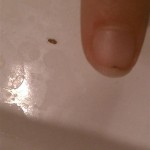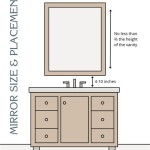Installing a Drain in Your Bathroom Vanity: A Comprehensive Guide
Installing a drain in a bathroom vanity is a common plumbing task that can be undertaken by homeowners with basic plumbing knowledge and the correct tools. A properly installed drain ensures efficient water removal, prevents leaks, and maintains the functionality of the bathroom sink. This article details the step-by-step process for installing a drain, encompassing preparation, component assembly, and final testing.
The process begins with gathering the necessary tools and understanding the anatomy of a bathroom sink drain. A typical drain assembly comprises several key components: the tailpiece (the vertical pipe extending from the sink), the drain flange (the piece that sits flush against the sink basin), the rubber or silicone washer (providing a watertight seal between the flange and the sink), the lock nut (securing the flange to the sink), a P-trap (preventing sewer gases from entering the bathroom), and connecting pipes and fittings.
Preparing for the Installation
Prior to commencing the physical installation, adequate preparation is crucial. This stage involves gathering the required tools and materials, shutting off the water supply, and removing the old drain assembly.
Gathering Tools and Materials: The following tools and materials will typically be required for a successful drain installation: a basin wrench (also known as a sink wrench, for loosening and tightening nuts in tight spaces), channel-lock pliers (for gripping and turning pipes), plumber's putty or silicone sealant (for creating watertight seals), a bucket (to catch water), a putty knife or scraper (for removing old putty), a pipe wrench (for larger pipe connections, if necessary), a level (to ensure proper drain alignment), and safety glasses and gloves (for personal protection). Ensure the new drain assembly is compatible with the existing plumbing configuration, taking into account the size and type of connections.
Shutting Off the Water Supply: Locate the shut-off valves beneath the sink. These valves control the hot and cold water supply to the faucet. Turn both valves clockwise until they are completely closed. If shut-off valves are not present or are malfunctioning, it may be necessary to shut off the main water supply to the house. Test the faucet to ensure that the water flow has been completely stopped. This prevents water damage during the drain removal and installation process.
Removing the Old Drain Assembly: Place a bucket underneath the existing drain assembly to catch any remaining water. Using the basin wrench or channel-lock pliers, loosen the slip nuts that connect the P-trap to the tailpiece and the drainpipe extending from the wall. Carefully detach the P-trap and remove it from beneath the sink. Next, loosen the lock nut that secures the drain flange to the sink basin. Once the lock nut is loose, gently push the drain flange upward from below the sink to detach it from the sink basin. Use a putty knife or scraper to remove any old plumber's putty or silicone sealant from the sink basin and the drain opening. Clean the area thoroughly to ensure a smooth surface for the new drain flange.
Assembling and Installing the New Drain
With the old drain removed and the area prepared, the next step involves assembling the new drain components and installing them in the sink and to the existing plumbing.
Preparing the Drain Flange: Begin by applying a rope of plumber's putty or a bead of silicone sealant around the underside of the drain flange rim. Ensure the putty or sealant is applied evenly to create a watertight seal between the flange and the sink basin. Alternatively, some drain kits come with a rubber or silicone gasket which should be positioned beneath the flange according to the manufacturer's instructions. This method is often preferred for its cleaner application and more reliable seal.
Inserting the Drain Flange and Securing it to the Sink: Carefully insert the drain flange into the drain opening from above the sink basin. Ensure that the flange sits flush against the sink surface. From below the sink, slide the rubber or silicone washer onto the tailpiece. Then, thread the lock nut onto the tailpiece and tighten it by hand. Use the basin wrench to further tighten the lock nut, securing the drain flange to the sink. Avoid overtightening, as this can damage the sink or the drain flange. The goal is to achieve a snug fit that prevents leaks without applying excessive pressure.
Connecting the Tailpiece and P-Trap: Attach the tailpiece to the bottom of the drain flange by threading it into the drain flange assembly. Ensure the connection is snug but not overtightened. Next, position the P-trap beneath the tailpiece. The P-trap is designed to trap water, preventing sewer gases from entering the bathroom through the drain. Connect the P-trap to the tailpiece using a slip nut and washer. Then, connect the other end of the P-trap to the drainpipe extending from the wall, again using a slip nut and washer. Tighten all slip nuts by hand initially, then use channel-lock pliers to further tighten them. Ensure that the P-trap is properly aligned and that all connections are secure. It may be necessary to adjust the length of the tailpiece or the drainpipe using extension pieces to achieve the correct fit. These extension pieces are available at most hardware stores.
Testing and Final Adjustments
After completing the drain assembly, thorough testing is critical to verify the integrity of the installation and identify any potential leaks. This step also includes making any necessary adjustments to ensure proper drainage.
Checking for Leaks: Turn on the water supply to the faucet slowly. Allow water to flow into the sink basin while carefully inspecting all connections for leaks. Pay close attention to the drain flange, the tailpiece connection, and the slip nut connections on the P-trap. If any leaks are detected, immediately turn off the water supply and tighten the affected connections. If tightening the connections does not resolve the leaks, it may be necessary to disassemble the joint, reapply plumber's putty or silicone sealant, and reassemble the connection.
Ensuring Proper Drainage: After confirming that there are no leaks, check to ensure that the water drains properly from the sink basin. Fill the sink with water and then release the drain stopper. Observe the water flow to ensure that it drains freely and without any obstructions. If the water drains slowly, it may be due to a blockage in the drainpipe. In this case, use a plunger or a drain snake to clear any obstructions. Alternatively, the slow drainage could be due to improper venting. Venting allows air to enter the drain system, which helps to facilitate water flow. If the drain system is not properly vented, it can create a vacuum that impedes drainage.
Final Adjustments and Cleanup: Once the drain installation is complete and all leaks have been addressed, make any necessary final adjustments to the drain assembly. Ensure that all connections are secure and that the P-trap is properly aligned. Clean up any excess plumber's putty or silicone sealant from around the drain flange. Dispose of any used materials properly. Run water through the drain for several minutes to flush out any debris that may have entered the drain system during the installation process.
By following these steps carefully, homeowners can successfully install a bathroom sink drain and ensure its proper function and watertight integrity. Proper installation not only prevents water damage but also extends the life of the plumbing system and contributes to a functional and aesthetically pleasing bathroom.
Regular maintenance, such as periodically cleaning the drain to remove hair and debris, will help to prevent clogs and maintain the efficiency of the drain system over time. This simple preventative measure can save time and money by avoiding costly plumbing repairs in the future.
How To Install Bathroom Sink Drain Queen Bee Of Honey Dos

Bathroom Sink Plumbing Installation Diy Montreal
How To Install Bathroom Sink Drain Queen Bee Of Honey Dos

How To Replace A Rusty Sink Drain Howtolou Com

How To Install A Vessel Sink Faucet
How To Install Bathroom Sink Drain Queen Bee Of Honey Dos

Bathroom Sink Plumbing Installation Diy Montreal

How To Install A Bathroom Sink Hooking Up Drain

Can I Install Bathroom Vanity Plumbing Through The Floor Loo Academy Under Sink Moving

How To Install A Veneto Bath Floating Bathroom Vanity






